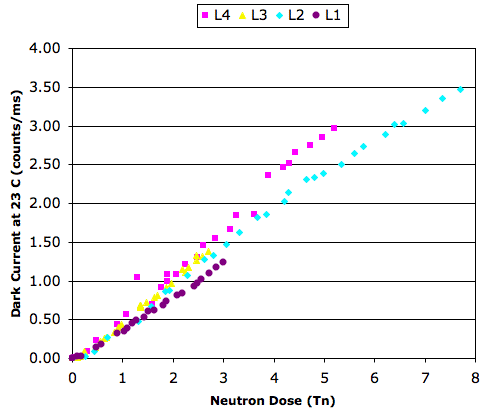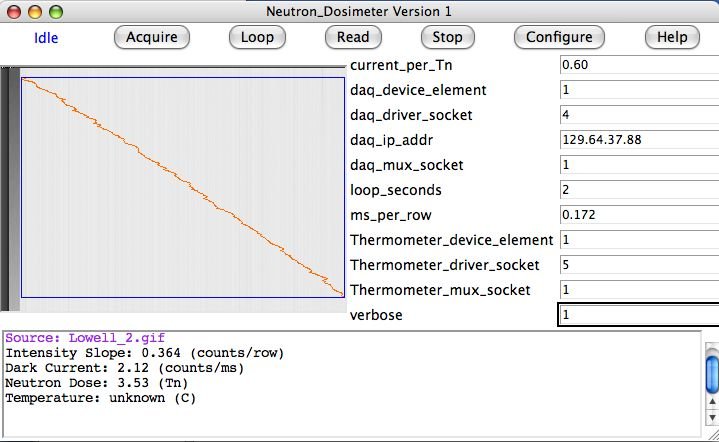Alignment for High Luminosity
Muon Upgrade Meeting
CERN, 24-AUG-09
Kevan Hashemi
Physics Department
Brandeis University
http://www.bndhep.net
Contents
Detector Integration
Radiation Background
Sensitivity to Neutrons
Temperature and Dark Current
Temperature Compensation
Neutron Dosimeter
Ionizing Dose
Rad-Hard Light Sources
Conclusion
Detector Integration
Phase One Upgrade of End-Cap Small Wheel:
- Brandeis will maintain drawings of end-cap muon system.
- Three or more groups have competing proposal for CSC region upgrade.
- Brandeis will work with all groups on layout of their detectors.
- Brandeis will design an alignment system for each proposal.
- Brandeis will build alignment system for final proposal.
Phase Two Upgrade of End-Cap Small Wheel:
- May involve replacement of entire small wheel.
- New wheel must cooperate with existing alignment system.
- Brandeis will work with all groups to coordinate layout of new wheel.
- Brandeis will design and build alignment system for new wheel.
Main contacts at Brandeis for Integration Work:
- Andrey Dushkin, Mechanical Engineer, based in Boston
- Jim Bensinger, Proffessor of Physics, based in Boston.
Radiation Background
Motivation for Radiation Studies:
- Phase Two alignment system must endure the Phase Two background.
- Phase Two background may require new, rad-hard alignment devices.
- Phase Zero background will inform our estimate of Phase Two background.
Propose to use alignment system to measure Phase Zero background:
- Image sensor dark current proportional to neutron dose.
- Device current consumption increases with ionizing dose.
Sensitivity to Neutrons
- End-cap alignment system uses TC255P CCD image sensors.
- Digitize pixels into eight-bit values, units are counts.
- Pixels fill up with dark current even in absence of light.
- Alignment system measures dark current in counts/ms.
- Dark current proportional to neutron dose.
 |
- MOUON-98-253, 1998
- MOUON-2000-011, 2000
- Dark current increased linearly with time.
- Sensors L2 and L4 at closer range.
- Sensors L1 and L3 at farther range.
- 1 Tn = 1012 1-MeV eq. n/cm2.
- Max simulated end-cap dose 0.8 Tn.
- Alignment system tolerates 4 counts/ms.
|
Temperature and Dark Current

|
- Neutron damage heals rapidly at 200°C (L4).
- After 200°C bake, no further healing (L4).
- Neutron damage heals slowly at 20°C.
- Dark current drops 10% in 1 yr.
- Dark current drops 60% in 11 yrs.
- Healing raises our radiation tolerance.
|
Temperature Compensation

|
- I = βD eαT
- I is dark current
- D is neutron dose
- α = 0.082 /°C
- β = 0.41 counts/ms/Tn
- Ignores anealing
- I doubles every 8.5 °C
|
- Precision in T for ATLAS is better than 0.2°C rms.
- Error in D due to T will be less than 2% rms.
Neutron Dosimeter
- Columns 8 to 18 in TC255P are covered with aluminum.
- Read out takes 172 μs per row.
- Vertical intensity gradient gives dark current.
- Combine dark current with temperature to get neutron dose

- Precision in I is 0.001 counts/ms, so error in D is 0.002 Tn.
Ionizing Dose
- Current consumption of CMOS logic chips increases with ionizing dose.
- Initial experiments with cobolt-60 sources showed increase.
- Radiation hardness experiments used high, fast doses.
- Experiments with slow, low, doses may reveal current-dose relationship.
- Considering experiments at Brookhaven's cobolt-60 facility.
Rad-Hard Light Sources
Light sources without electronics provide better tolerance to radiation.
| Device
| Resolution (μm) |
| BCAM Laser Diodes |
0.24 |
| Retroreflective Corner-Cube |
0.28 |
| Plastic Light Pipe Diameter 250 μm, Length 1.7 m |
0.59 |
| Plastic Light Pipe Diameter 250 μm, Length 5.8 m |
0.34 |
| Retroreflective Tape |
1.9 |
| Single Mode Fiber |
0.74 |
Table: Light Source Performance at Range 1.5 m
Unable to obtain adequate images with steel ball reflectors at 1.5 m.
Optical fiber is radiation resistant and provides good resolution.
Must figure out an inexpensive way to couple laser light into fibers.
Plastic light pipes easier to couple to laser, but may not be rad-hard.
Our current work in Light Sources report on BCAM Home Page.
Conclusion
- Brandeis committed to coordinating integration of new detectors.
- Brandeis committed to building new alignment systems for new detectors.
- Hope to measure neutron dose to 0.002 Tn or 2%, whichever is greater.
- Max end-cap simulated dose per year is 0.08 Tn.
- Investigating using logic circuit current to measure ionizing dose.
- Investigating various new BCAM light sources.
- Light sources made with optical fibers would be rad-hard.



